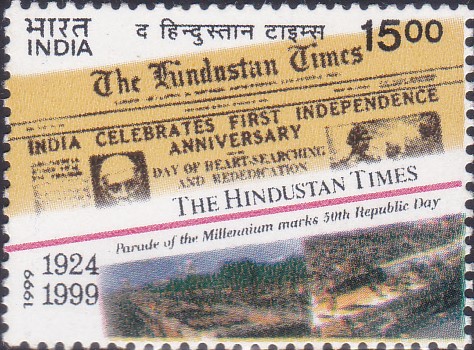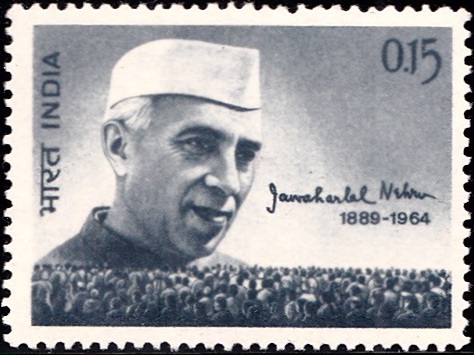
The Hindustan Times (1924-99)
A commemorative postage stamp on the 75th Anniversary of The Hindustan Times, an Indian English-language daily newspaper :

 Issued by India
Issued by India
Issued on Dec 16, 1999
Issued for : The Department of Posts is happy to issue this commemorative stamp on the occasion of the 75th anniversary of The Hindustan Times.
Design : The stamp and first day cover designs seek to immortalize historic events in the country’s history through coverage of headlines for the date.
Credits :
Stamp & First Day Cover : The Hindustan Times
Cancellation : Alka Sharma
Type : Stamp, Mint Condition
Colour : Multi Colour
Denomination : 1500 Paise
Overall size : 3.91 x 2.90 cms.
Printing size : 3.55 x 2.54 cms.
Perforation : 13 x 13
Paper : Imported un w/m Adhesive Gravure Coated Stamp Paper in Sheets 50.8 x 53.5 cms.
Stamps Printed : 1 Million
Number per issue sheet : 35
Printing Process : Photogravure
Printer : India Security Press, Nashik
About :
- The Hindustan Times, one of the premier newspaper of the country, was started as an evening daily in Delhi in 1924. The first issue inaugurated by Mahatma Gandhi and carrying articles by Motilal Nehru, Muhammed Ali Jinnah and Jawaharlal Nehru was launched on September 24, 1924. In 1925, ownership of the newspaper passed on to Pandit Madan Mohan Malviya.
- Because of its patriotic leaning, the newspaper, many times came close to incurring the imperialist wrath of the British. In 1930, publication was closed in protest against the draconian anti-press law in the wake of the Salt Satyagraha. The following year, when the authorities ordered the press to blackout some of the fiery speeches of Jawaharlal Nehru, the Hindustan Times set up a make shift press and got a collection of those speeches printed and arranged the despatch of thousands of copies to all parts of the country. A confrontation with the British establishment ensued and the newspaper was forced to furnish huge securities to rein in its nationalist zeal.
- Just when bankruptcy appeared imminent, G.D. Birla, pioneer and visionary stepped in. He went on to nurture the newspaper into a great institution attracting the finest editorial and managerial talent. In an era when long editorials and text-of-speech reporting were in vogue, The Hindustan Times ventured into short editorials, reporting a wide range of events and carried news on the front page with bold headlines.
- The efforts of a succession of brilliant editors made it impossible for the British rulers and the educated elite to ignore it. The paper also became a nursery of varied journalistic talent.
- After independence, the newspaper extended full-fledged support for nation building and the government’s efforts for growth and development. Standing for democracy, free enterprise and liberal values, The Hindustan Times acquired a reputation for fairness among the readers. In the early seventies The Hindustan Times introduced a unique social experiment titled “our village Chhatera”. The project took over development activities of a village, such as the setting up of school, health clinic and income-generating activities. This display of social commitment earned kudos for the newspaper from both national and international institutions.
- Over the years, The Hindustan Times has adapted itself to the technological changes in the mass media. It has acquired modern printing equipment and achieved total computerisation of the process of printing and news gathering. With attractive colour pull-outs and informative feature pages embellishing the main paper, The Hindustan Times has succeeded in catering to the changing tastes of its readers.








[…] Ltd., Texmaco Ltd., Sutlej Textiles & Industries Ltd., HT Media Ltd. the publisher of Hindustan Times, besides other publications that include Hindustan and […]
[…] and national events attracted the attention of the newspapers and of the public. He joined ‘The Hindustan Times’ in 1932 and continued as staff cartoonist till […]
[…] contribution to the field of journalism. He started his journalistic career as the Editor of the Hindustan in 1887. Two years later, he joined the “Indian Union“ as Editor in which capacity, he […]
[…] was a veteran journalist, too. For varying periods, he was the editor of The Hindu, The Hindustan Times and of Gandhiji‘s weekly Young India. In 1924, he was appointed as the General Secretary of […]
[…] of Kolkata and Delhi from 1937 to 1943. He became Joint Editor and political columnist of the Hindustan Times in April 1944 and Chief Editor of the paper in 1957. He founded The India News and Feature […]